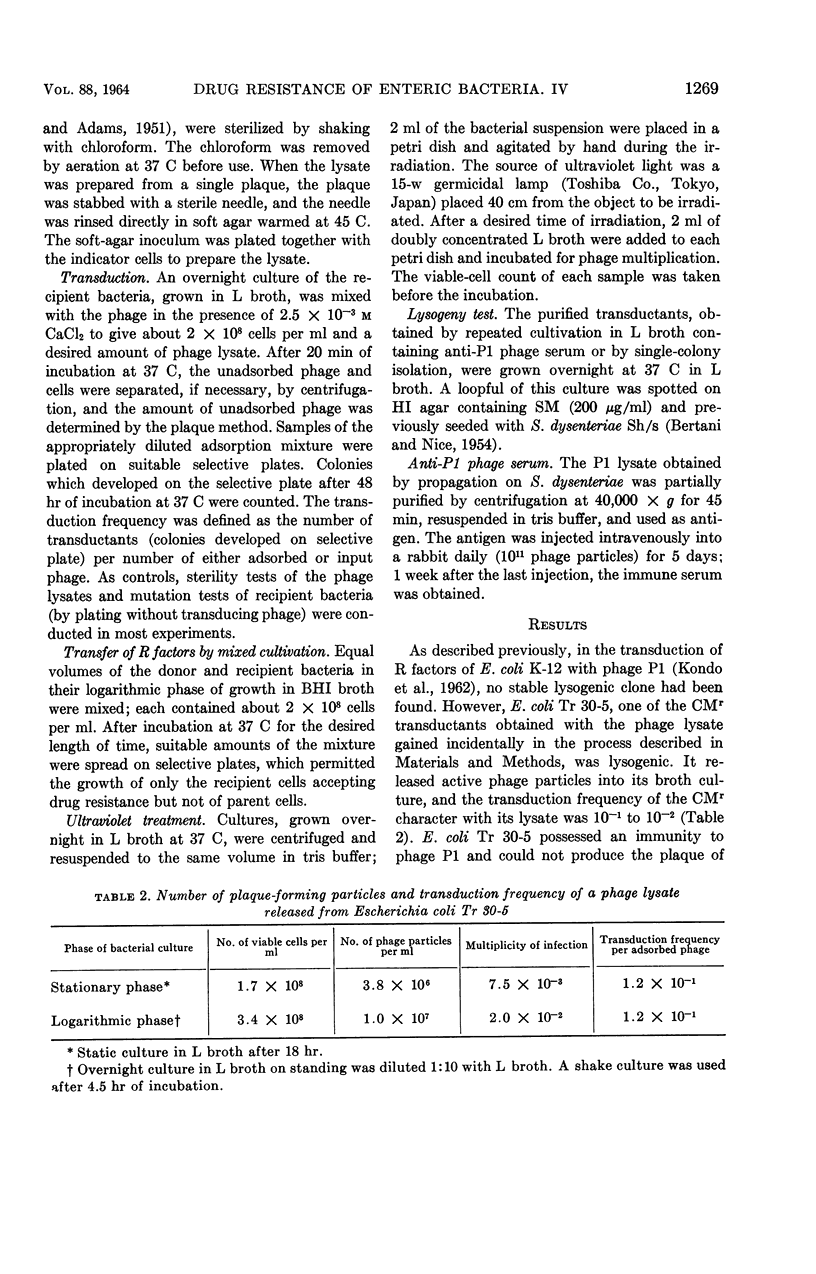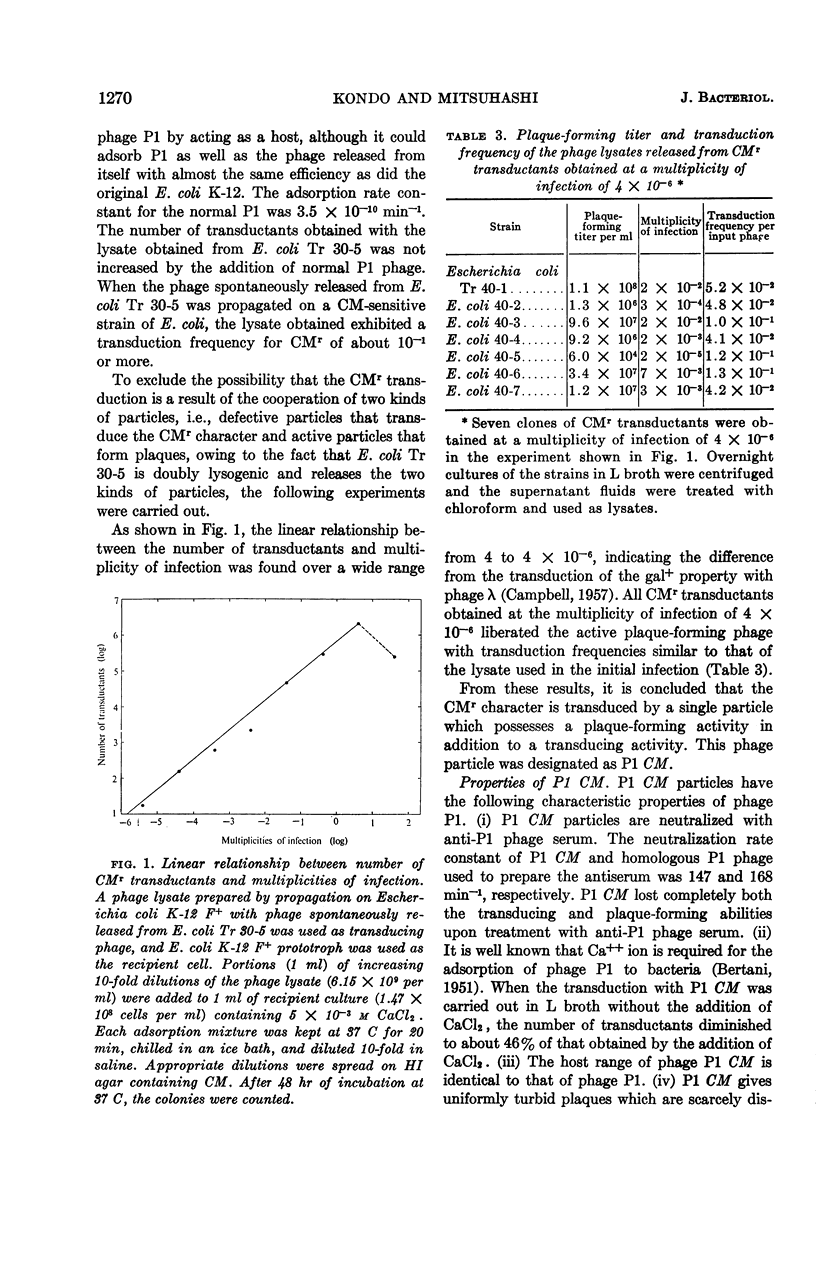Abstract
Kondo, Eiko (Gunma University, Maebashi, Japan), and Susumu Mitsuhashi. Drug resistance of enteric bacteria. IV. Active transducing phage P1 CM produced by the combination of R factor with phage P1. J. Bacteriol. 88:1266–1276. 1964.—During an investigation of the transduction of R factors with phage P1, a phage lysate capable of transducing the character of chloramphenicol resistance (CMr) in extremely high frequency was obtained. The transduction of the CMr character with the lysate was consistently accompanied by lysogenization with the phage used for transduction. This lysate exhibits no beneficial effect with normal P1, and no effect is produced by decreasing the multiplicity of infection. A single infection with the phage allows the formation of plaques as well as CMr lysogenic cells at the center of the plaque. Both the transducing and plaque-forming activities of the lysate were lost by neutralization with anti-P1 phage serum, and its absorption to the host bacteria was enhanced by the addition of Ca++. Thus, it was concluded that a derivative of P1 phage (P1 CM) was isolated which had not only the ability to transduce the CMr character but also the capacity to form plaques; i.e., the CMr gene of R factor is specifically associated with the genome of phage P1. No detectable differences were noted between P1 CM and normal P1 phage in density-gradient analyses in CsCl, in stability of lysogenization, in ability to transduce chromosomal markers, and in the mode of induction from lysogenic cells by ultraviolet irradiation. The instance of transduction of the CMr character described here may also be considered as an example of lysogenic conversion, in the sense that the alteration in CMr character is inseparable from lysogenicity.
Full text
PDF










Selected References
These references are in PubMed. This may not be the complete list of references from this article.
- ARBER W., KELLENBERGER G., WEIGLE J. La défectuosité du phage lambda transducteur. Schweiz Z Pathol Bakteriol. 1957;20(5):659–665. [PubMed] [Google Scholar]
- ARBER W. Transduction of chromosomal genes and episomes in Escherichia coli. Virology. 1960 May;11:273–288. doi: 10.1016/0042-6822(60)90066-0. [DOI] [PubMed] [Google Scholar]
- Adams J. N., Luria S. E. TRANSDUCTION BY BACTERIOPHAGE P1: ABNORMAL PHAGE FUNCTION OF THE TRANSDUCING PARTICLES. Proc Natl Acad Sci U S A. 1958 Jun;44(6):590–594. doi: 10.1073/pnas.44.6.590. [DOI] [PMC free article] [PubMed] [Google Scholar]
- BERTANI G., NICE S. J. Studies on lysogenesis. II. The effect of temperature on the lysogenization of Shigella dysenteriae with phage P1. J Bacteriol. 1954 Feb;67(2):202–209. doi: 10.1128/jb.67.2.202-209.1954. [DOI] [PMC free article] [PubMed] [Google Scholar]
- BERTANI G. Studies on lysogenesis. I. The mode of phage liberation by lysogenic Escherichia coli. J Bacteriol. 1951 Sep;62(3):293–300. doi: 10.1128/jb.62.3.293-300.1951. [DOI] [PMC free article] [PubMed] [Google Scholar]
- Barksdale L. I. : Lysogenic Conversions in Bacteria. Bacteriol Rev. 1959 Dec;23(4):202–212. doi: 10.1128/br.23.4.202-212.1959. [DOI] [PMC free article] [PubMed] [Google Scholar]
- CAMPBELL A. Transduction and segregation in Escherichia coli K12. Virology. 1957 Oct;4(2):366–384. doi: 10.1016/0042-6822(57)90070-3. [DOI] [PubMed] [Google Scholar]
- GAREN A., ZINDER N. D. Radiological evidence for partial genetic homology between bacteriophage and host bacteria. Virology. 1955 Nov;1(4):347–376. doi: 10.1016/0042-6822(55)90030-1. [DOI] [PubMed] [Google Scholar]
- HARADA K., KAMEDA M., SUZUKI M., MITSUHASHI S. DRUG RESISTANCE OF ENTERIC BACTERIA. II. TRANSDUCTION OF TRANSMISSIBLE DRUG-RESISTANCE (R) FACTORS WITH PHAGE EPSILON. J Bacteriol. 1963 Dec;86:1332–1338. doi: 10.1128/jb.86.6.1332-1338.1963. [DOI] [PMC free article] [PubMed] [Google Scholar]
- JACOB F. Transduction of lysogeny in Escherichia coli. Virology. 1955 Jul;1(2):207–220. doi: 10.1016/0042-6822(55)90017-9. [DOI] [PubMed] [Google Scholar]
- KONDO E., HARADA K., MITSUHASHI S. Drug-resistance of enteric bacteria. 12. Transduction of the transmissible drug resistance factor by bacteriophage Plkc. Jpn J Exp Med. 1962 Feb;32:139–147. [PubMed] [Google Scholar]
- LENNOX E. S. Transduction of linked genetic characters of the host by bacteriophage P1. Virology. 1955 Jul;1(2):190–206. doi: 10.1016/0042-6822(55)90016-7. [DOI] [PubMed] [Google Scholar]
- LURIA S. E., ADAMS J. N., TING R. C. Transduction of lactose-utilizing ability among strains of E. coli and S. dysenteriae and the properties of the transducing phage particles. Virology. 1960 Nov;12:348–390. doi: 10.1016/0042-6822(60)90161-6. [DOI] [PubMed] [Google Scholar]
- MATSUSHIRO A. Specialized transduction of tryptophan markers in Escherichia coli K12 by bacteriophage phi-80. Virology. 1963 Apr;19:475–482. doi: 10.1016/0042-6822(63)90041-2. [DOI] [PubMed] [Google Scholar]
- Meselson M., Stahl F. W., Vinograd J. EQUILIBRIUM SEDIMENTATION OF MACROMOLECULES IN DENSITY GRADIENTS. Proc Natl Acad Sci U S A. 1957 Jul 15;43(7):581–588. doi: 10.1073/pnas.43.7.581. [DOI] [PMC free article] [PubMed] [Google Scholar]
- Morse M L, Lederberg E M, Lederberg J. Transduction in Escherichia Coli K-12. Genetics. 1956 Jan;41(1):142–156. doi: 10.1093/genetics/41.1.142. [DOI] [PMC free article] [PubMed] [Google Scholar]
- NAKAYA R., NAKAMURA A., MURATA Y. Resistance transfer agents in Shigella. Biochem Biophys Res Commun. 1960 Dec;3:654–659. doi: 10.1016/0006-291x(60)90081-4. [DOI] [PubMed] [Google Scholar]
- SHEPPARD D. E. Density gradient centrifugation of bacteriophage P22. Virology. 1962 May;17:212–214. doi: 10.1016/0042-6822(62)90105-8. [DOI] [PubMed] [Google Scholar]
- STARLINGER P. Uber einen Defekt des transduzierenden Salmonella-Phagen P22. Z Naturforsch B. 1958 Aug;13B(8):489–493. [PubMed] [Google Scholar]
- SWANSTROM M., ADAMS M. H. Agar layer method for production of high titer phage stocks. Proc Soc Exp Biol Med. 1951 Nov;78(2):372–375. doi: 10.3181/00379727-78-19076. [DOI] [PubMed] [Google Scholar]
- TING R. C. The specific gravity of transducing particles of bacteriophage P1. Virology. 1962 Feb;16:115–121. doi: 10.1016/0042-6822(62)90286-6. [DOI] [PubMed] [Google Scholar]
- UETAKE H., LURIA S. E., BURROUS J. W. Conversion of somatic antigens in Salmonella by phage infection leading to lysis or lysogeny. Virology. 1958 Feb;5(1):68–91. doi: 10.1016/0042-6822(58)90006-0. [DOI] [PubMed] [Google Scholar]
- UETAKE H., UCHIDA T. Mutants of Salmonella phage e 15 with abnormal conversion properties. Virology. 1959 Dec;9:495–505. doi: 10.1016/0042-6822(59)90144-8. [DOI] [PubMed] [Google Scholar]
- WATANABE T., FUKASAWA T. Episome-mediated transfer of drug resistance in Enterobacteriaceae. III. Transduotion of resistance factors. J Bacteriol. 1961 Aug;82:202–209. doi: 10.1128/jb.82.2.202-209.1961. [DOI] [PMC free article] [PubMed] [Google Scholar]
- WATANABE T. Infective heredity of multiple drug resistance in bacteria. Bacteriol Rev. 1963 Mar;27:87–115. doi: 10.1128/br.27.1.87-115.1963. [DOI] [PMC free article] [PubMed] [Google Scholar]
- ZINDER N. D., LEDERBERG J. Genetic exchange in Salmonella. J Bacteriol. 1952 Nov;64(5):679–699. doi: 10.1128/jb.64.5.679-699.1952. [DOI] [PMC free article] [PubMed] [Google Scholar]


